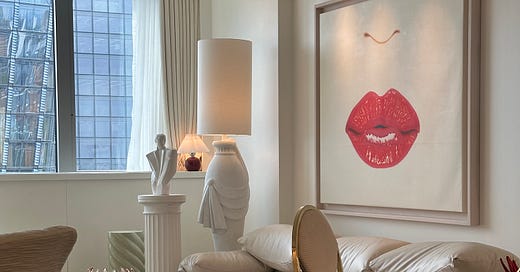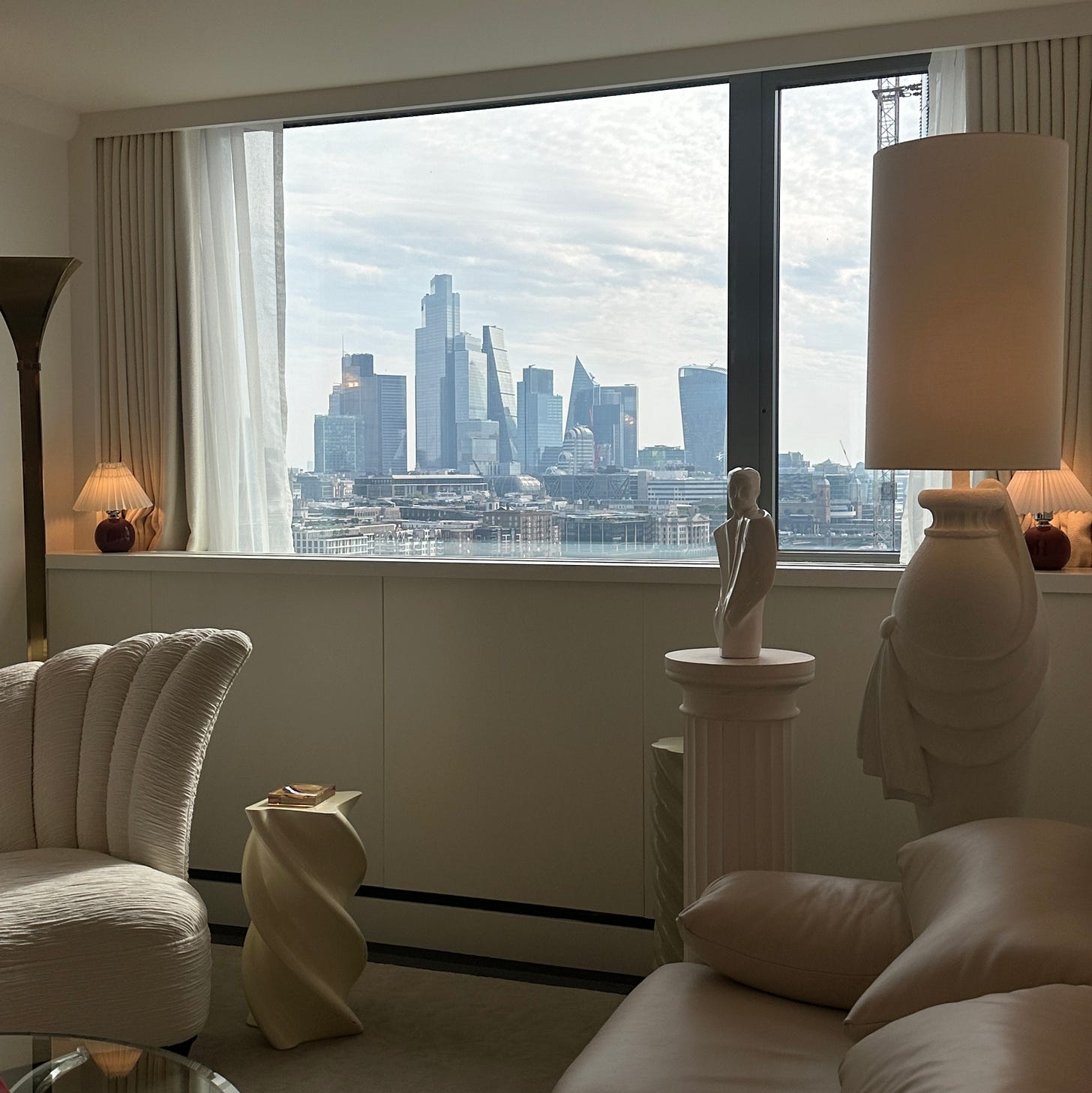A Beloved London Hotel Gets a Little Extra
Plus, the French tricking Americans with cheap wine, what annoys Tokyo visitors, the perplexing José Andrés hotel play, and an ambitious proposal for Venice.
Getting Around turned a year old recently, and as part of finding ways to make it sustainable, I’m trying out having it sponsored now and then. So, for the next few weeks, Getting Around with William O’Connor is sponsored by Medjet, the global air medical transport and travel security membership program. Here’s a little note from them about the program:
“One in 30 trips ends in a medical emergency, and safety while traveling has become a growing concern. Protect yourself with Medjet. Insurance gets you to the ‘nearest acceptable facility.’ Medjet membership can get you home.”
Click here for more info about Medjet :)
If you are a habitual reader of travel company earnings reports or have paid attention to interviews given by their execs, one thing has been consistent in this turbulent time—the insatiable demand for luxury travel by wealthy Americans.
It has kept the cash flowing for airlines, allowed five-star hotels in Paris to wildly inflate room rates, funded expansion by tour companies, and triggered a rush by countless hotels to update or enhance offerings that might attract these profligate passengers.
This past weekend, I stopped in London to see one such project, the new cabin suites at Sea Containers Hotel on the River Thames. Sprouting from the mind of parent company LORE Group’s creative director Jacu Strauss, the four new luxury suites are inspired by four revival styles—Edwardian, Art Deco, Midcentury Modern, and 80s Dynasty.
For the unfamiliar, Sea Containers is one of those hotels that, more than a decade after opening, remains beloved but is no longer the hot new thing. It still plays host to one of the top-ranked bars in the world (Lyaness), the location is great for those exploring central London, and its position on a bend in the river gives its generally large rooms great views.
All those qualities will keep your occupancy rate high, but it won’t tap into that ultra-lucrative clientele. It also won’t get you press, as the travel media complex is, with a few exceptions, focused on everything new when it comes to hotels. Plus, the window for trend-relevant design is ever shrinking, so even if its look won plaudits a decade ago, there’s a pressure to do something to appease changing tastes.
Revival styles can be tricky. You want to hit the aesthetic notes that make clear you’re drawing on a specific era, but you don’t want it to verge into kitsch. You also want its functions to match the modern traveler.
Each of the new cabin suites has a similar layout, with a half bath at the entrance, a living room, and then a bedroom with an en-suite. The three more “traditional” styles chosen—Edwardian, Art Deco, and Midcentury—hit those sweet spots of aesthetic familiarity with modern comfort.
I remain partial to Strauss’s elegant use of cork, a signature look going back to the Lyle Hotel in Washington, D.C., that he revisits in the Art Deco suite. The metal bathtub here, with the painting above, is a particularly elegant moment. After experiencing some pretty horrible art in the new Ned members club in D.C., I appreciated how much interesting art is interspersed throughout the suites.
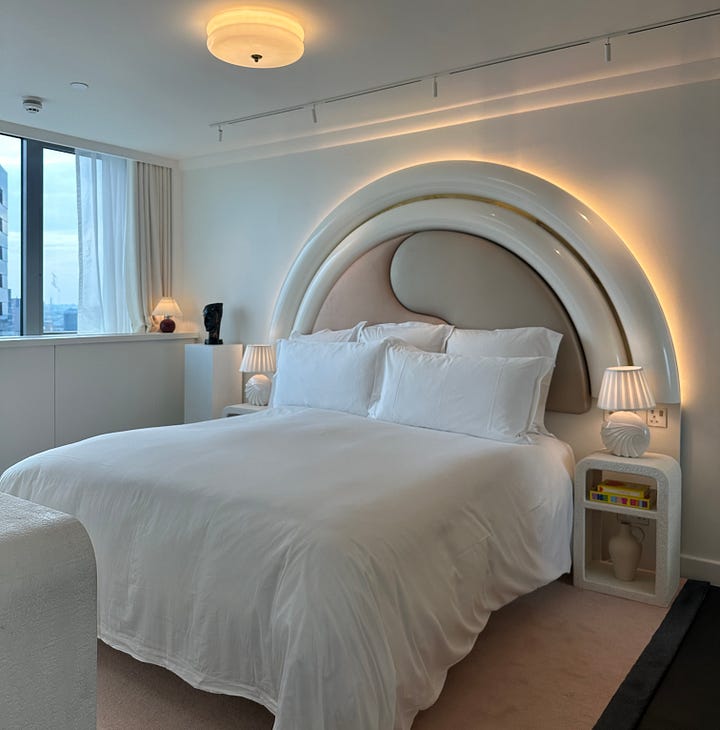
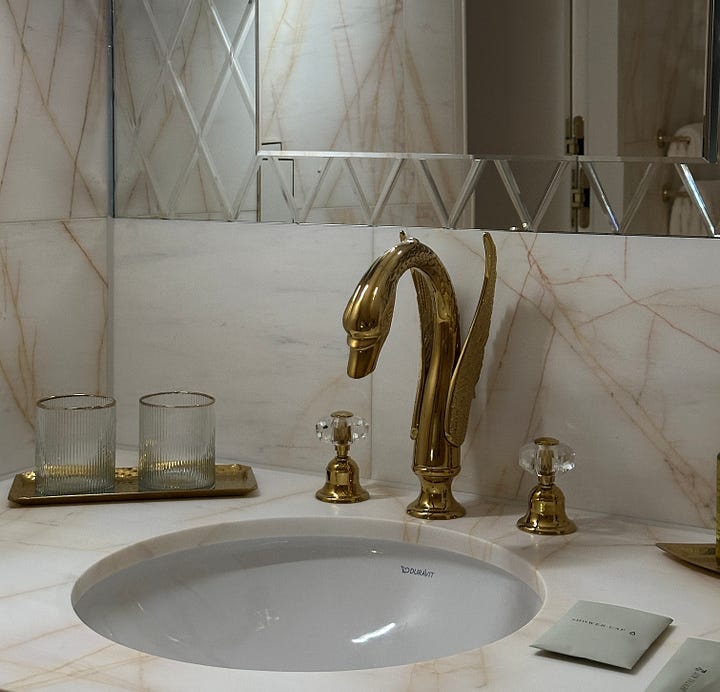
Now, if revival styles generally are risky for verging into kitsch, going for a Dynasty-type 80s look is even more so. I’ve known Jacu for a few years now, and he’s one of a number of people I’ve drawn into hypothetical debates about what the eventual return of the 80s would look like. After all, we’ve hit that 40-year window when nostalgia hits for a past era. My hunch had been something Wall Street/American Psycho-ish, with geometric polished stone, chrome, and lots of hard, cold surfaces. Jacu’s bet, and one I immediately came around to upon stepping into the room, is that something like the white-and-gold Texas extravagance is more the template.
DEPARTMENT OF GRIEVANCES
No matter how much friendlier towards Americans the French are becoming, they just can’t help seeing us as uncouth rubes. Le Parisien is out with a not entirely shocking report about widespread wine fraud in Paris. It turns out restaurants and cafes have been serving unrefined tourists cheaper wine than they ordered. Two potential solutions for you exist. The first is to insist that the glass be poured in front of you. This seems like it could be difficult if you don’t speak French well and are already dealing with a surly waiter. The second option would be to just assume you’re going to be drinking a fair amount and order the bottle so you know exactly what you’re getting.
The first time I visited Tokyo, I was obsessed with the food courts in high-end malls. So much so that by the fourth day at my favorite bun counter the woman would see me coming and start getting my order ready. But two things really irritated me about the experience. The first was just how much single-use plastic was used on takeaway items. It was almost like folks had been given a challenge to come up with creative ways to add more wrap, containers, and bags. The second was that if I went to eat it outside, there was never a trash can anywhere. Apparently, that frustration is not unique to me, as a new government survey from Japan found that the biggest complaint visitors had, yet again, was the lack of public trash cans.
One thing that always irritates me is how hotels tightly wrap bathrobes. I love luxuriating in a nice robe after a shower, but it’s always a tiny struggle to pry apart the knotted belt. I get that it looks good, but it’s very impractical.
I mentioned a couple of weeks ago that there were a few touchpoints in the travel industry I’m keeping an eye on to see how things will play out economically. I was remiss in mentioning one of the most sensitive destinations out there–Las Vegas. And things are already looking pretty bleak for the tourism-dependent city. Numbers plummeted in February compared to the year before (partly because of hosting the Super Bowl in 2024), and in March, air passengers continued to drop.
For at least a year now, I’ve dreaded flying through Newark Liberty. Which is tough, since the airline I have status with is United. But it’s been plagued by staff shortages, chaos, terrible transit options, and outdated facilities. When I wrote previously about the safety of flying, every expert I talked to was less worried about Boeing planes and more about human errors at ATC (Air Traffic Control). Unfortunately, sometimes it takes a crisis for much-needed reforms to happen, and the state of things at Newark right now very much seems like a crisis. If only for reasons of not risking disruption to your trip alone, I’d avoid connecting there if you can.
My experiences on Air Canada have rarely lived up to its billing as a major airline. Long-haul flights without wi-fi, onerous flight change fees, and so on. But on at least one front, it’s making progress—it will be offering free wi-fi on flights in North America and the Caribbean, sponsored by Bell. The airline claims the service will be good enough to stream videos.
Without details of what a potential JetBlue and United partnership would look like (or whether it would even be allowed), it’s hard to opine on it, but given the steady shrinking of U.S. airline competition, whatever allows a healthy JetBlue would be good in my book.
It’s hard to believe this still needs to be said, but DO NOT APPROACH WILDLIFE, especially bison! Every year, there are dozens of incidents, and we can add another man being gored by a bison in Yellowstone to the list. The 47-year-old apparently was getting too close for the animal’s comfort, and it attacked.
The collab between Foster+Partners and Porsche for a new dock in Venice is ugly IMO. Looks very 2015 both in terms of shape and materials…
I don’t know what to think yet of celebrity chef José Andrés’s foray into hotels. His group is opening their first hotel in tony Georgetown in Washington, D.C. in 2027. I do, however, find their way of explaining what they’re up to in this Skift piece confusing. “No matter how luxurious you make a hotel, it's four walls and it's soulless, until you program the F&B,” the group’s CEO told the news outlet.
Now, I think that fundamentally misunderstands the hotel business that they’re planning a large foray into. There’s a reason F&B is so often an afterthought—what people are willing to pay for often has little or nothing to do with what they can eat or drink in that hotel.
But then the CEO goes on to say that they’re not actually doing hotels? They’re just doing F&B at hotels they create:
“What we're not looking to do is operate hotels … We welcome partnering with the major operators, our existing partners, Marriott, Hilton, and Hyatt. Let them do what they do best, which is fill the rooms and operate the hotel … Let us design it, let us create that ethos. Let us tell the stories and deliver that guest experience that's unique, and then let them leverage their machine.”
Huh? Then why go through all the trouble of creating a hotel if the end product is still just you running F&B like you already do at dozens of hotels? It reads like you think your existing partners aren’t doing a very good job at creating the hotels you want your restaurants in, but you still want them to run the ones you create?
The remodeled Sainsbury Wing of the National Gallery in London by Selldorf Architects is finished and open, and the architectural critic Robert Bevan is having absolutely none of it. Writing in Dezeen, he laments that the early critics who dubbed it "flimsy corporate blandness" and an "airport-concourse aesthetic" were right and finds much to dislike about this update to Robert Venturi and Denise Scott Brown’s work.



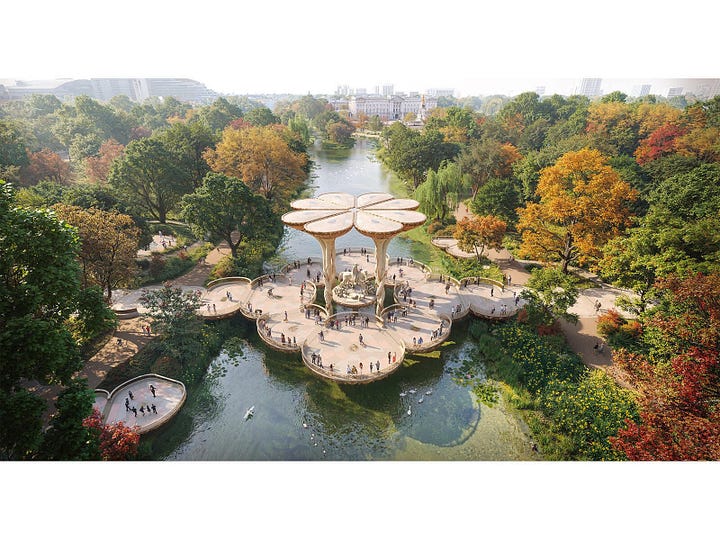

The online portal for feedback on the proposed designs for Queen Elizabeth II’s memorial in St. James Park is now open, with design proposals from Foster + Partners, Heatherwick Studio, J&L Gibbons, Tom Stuart-Smith, and WilkinsonEyre. All are bridges, and only Heatherwick’s has a bit of flair. I do think, though, that it will age poorly. Foster+Partners proposal looks like a highway overpass. All of them give me “meh,” but perhaps the proposal from J&L Gibbons is the most elegant, at least from what I’ve seen.
The interest in Mexico that accelerated during the pandemic (a combination of it being open and it being a workaround for citizens of banned countries to enter the U.S.) shows no sign of stopping. Despite last year being a massive year tourism-wise, the first quarter of 2025 was up 3.5%.
Which brings us to Europe and this summer, and if a new study from Allianz is to be believed, the number of Americans going across the Atlantic will be up an astonishing 10 percent from last year. What those crowds will look like, I shudder to imagine.
Expect to hear more about Chiclayo over the next few years. It’s the city in which the new Pope Leo was a bishop. It sits on the coast and is how one accesses numerous important pre-Columbian ruins and archaeological sites, and is also famous for its food.
TRAVEL INDUSTRY NEWS
The most overcrowded European destination is the Greek island of Zakynthos according to a new report
Two people hiking in the Czech Republic found a treasure trove worth over $340,000
Romania loses visa-free access to the U.S.
“Ghost bookings” on the rise as way to protect against issues at U.S. border
Catalonia is delaying the massive hike in its tourist tax until the fall
Could pumping water beneath Venice save it?
Activist groups are planning for anti-tourism demonstrations across Southern Europe on June 15
New York City cuts tourism forecast for 2025 by three million visitors
Expedia is launching a tool to build an itinerary based on an Instagram reel you send it

